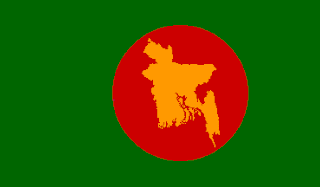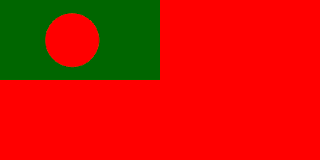



Civil and State FlagRed disc on green field. The disc is set slightly toward the hoist so that when the flag is flying it will appear to be in the center. Many illustrations (and probably actual flags, too) have the circle in the center in error, for example, the British Admiralty's Flags of All Nations - 1989. I do not know if the circle was centered when it also included the yellow map of the country. At home I have an example of a Bangladeshi postage stamp ca 1971 with the map on the flag, and I think it shows the circle in the center. Nick Artimovich, 26 August 1997
The red circle should actually be shifted towards the hoist since 1972. The previous flag (1971-1972) had a centered red disc with a yellow map silhouette of Bangladesh. Jan Zrzavy, 26 August 1997
The national flag is bottle green in color and rectangular in size with the length to width ratio of 10:6 bearing a red circle on the body of the green. The red circle has a radius of one fifth of the length of the flag. Its center is placed on the middle of the perpendicular drawn from the nine twentieth part of the flag. The background colour symbolizes the greenery of Bangladesh with its vitality and youthfulness while the red disc represents the rising sun and the sacrifice our people made to obtain our independence. Prescribed sizes of the flag for buildings are 305cm x 183cm, 152cm x 91cm and 76cm x 46cm and for vehicles are 38cm x 23cm and 25cm x 15cm. Collected from http://www.virtualbangladesh.com/bd_flag.html by Dov Gutterman, 23 December 1998.
(See also the Construction Sheet) Santiago Dotor, 26 February 2001
Civil Ensign
image by Željko Heimer
Red, with the national flag in canton. Jan Zrzavy, 16 January 1998
1971 Flag
image by Jorge Candeias, 29 May 1999
The first flag of Bangladesh. I don't know what the official proportions were, but I have used 2:3 as it seems reasonable to assume that the Pakistani practice would have continued for a while. Someone quoted Whitney Smith as saying that the map was omitted because of the difficulty involved in displaying it correctly on both sides. I have some doubts about this explanation: Cyprus has overcome the problem of a two-sided flag, as has Saudi Arabia. Another explanation suggests itself: namely, that the map may have been an unpleasant reminder of the partition of Bengal. Vincent Morley, 1 September 1997
The first flag of the independence movement. The flag initially had the the map of Bangladesh in gold in the center of the red circle. This was the original design of the flag of Bangladesh that the valiant freedom fighters fought under during the liberation war. On the 3rd March 1971, ASM Abdur Rab, the then VP of Dhaka University Students´ Union hoisted the flag for the first time at the historic Dhaka University location known as "bawt-tawla". This flag was also raised at the then Dhaka Race Course at then Ramna Racecourse (now Shuhrawardy Uddayan) when Sheikh Mujibur Rahman gave his historic speech proclaiming "this struggle is the struggle for liberation." (The "bawt-tawla" incidently means the shade of the banyan tree in Bengali. This was, and still is, a popular meeting place for activist students of the University of Dhaka.) Collected from http://www.virtualbangladesh.com/bd_flag.html by Dov Gutterman, 23 December 1998.
Reverse of 1971 Flag
by Jorge Candeias, 29 May 1999
I believe the map ought to be correct on both sides. Pedersen refers to the difficulty of rendering the map correct on both sides of the flag leading to dropping the map. Ole Andersen, 25 May 1999
Erroneous 1971 flag reports
image by Falko Schmidt
Browsing in my files I found a flag, published in an East German journal (NBI - Neue Berliner Illustrierte 13/73) and illustrated here. I don't know, if this flag was ever used. Can anyone help?Falko Schmidt, 29 September 2001
This flag is similar to one that I found on a flag plate in Dicionário Enciclopédico Koogan Larousse Selecções (Encyclopedic Dictionary Koogan Larousse Selecções), vol. 1. The disc is a lot smaller and it's not red, rather somewhere between purple and pink (lilac?). This colour isn't due to some glitch in the printing of the source, since adjacent flags that have red in them are perfectly normal (see image here). If so, and given the lack of any evidence (at least so far) that such a design was used, then I guess it is a case of perpetuating an error from one source to another. It appears to be erroneous.Jorge Candeias, 2 October 2001, 6 February 2005
Origin of the Flag
Modified from http://www.banglarglimpse.com/prelibhist.htm:"The national flag of Bangladesh was a product first conceived by painter Quamrul Hasan. On the 3rd March 1971, ASM Abdur Rab the then VP of Dhaka University Students' Union had the honour of hoisting the first flag of independent Bangladesh at the Dhaka University premises popularly known as Bat-tala. Bangabandhu Sheikh Mujibur Rahman hoisted the flag of independent Bangladesh at his residence, 32 Dhanmondi R/A, at the outskirt of Dhaka, on the 23rd March 1971. It was an unknown Awami League worker who hoisted the first flag of independence at the historical meeting at the then Ramna Race-course on the 7th March 1971 where Sheikh Mujib tacitly called for armed struggle against Pakistani occupation Army. For Quamrul Hasan, making and shaping of the flag needed several months to complete. Unique features of the first flag of independent Bangladesh were the absence of the crescent and star (as in the Pakistan's flag), symbol of the Islamic states. Sheikh Mujibur Rahman and the Bangalees dreamed for the secular Bangladesh.
The red circular disc with map of Bangladesh symbolizes blood of thousands of Bangalis killed by the Pakistanis since 1947 in the Golden Bangla. The green backdrop, needless to say, symbolizes the vitality, youthfulness, greenery and of course symbolizes also our land as agrarian since the pre-Vedic age. Many western writers have written an interpretation of the green backdrop of the Bangladesh flag as the colour of Islam which is essentially wrong information. Please note the Lonely Planet's Bangladesh 1996 edition. Here the author wrongly writes "First flown officially from the rebel Bangladesh embassy in Calcutta when the War of Liberation began". Writing partially correct "The Bangladesh flag is green for the lush country, not for Islam, as some fundamentalists would prefer". The CIA world factbook 1997 has also made the same mistake! The present flag, quite different from the first one, is bottle green in the background, voided of the golden-coloured map of Bangladesh, rectangular in size in the proportion of length to width 10:6. The red circle has a radius of one-fifth of the length of the flag. The red circle's centre is placed on the intersecting point of the perpendicular drawn from the nine-twentieth part of the length and the horizontal line drawn through the middle of its width. The flag of Bangladesh was first hoisted in the UN September 1974. China used her veto against admission of Bangladesh in the UN 1972 and repeated in the year 1973. The Bangladesh flag appeared later in the UN's stamp series "Flag of the member state". "A Bangladeshi now living in exile in Sweden Mr. Mahbubul Haque had the rare opportunity of being actively involved in the Flag Hoisting ceremony of independent Bangladesh at Bat-Tala premises of Dhaka University on the 3rd March 1971. According to him the more radical wing of the Bangladesh Chatra League led by ASM Abdur Rab hastily arranged an extra emergency meeting at Madhu's Canteen in the midnight between 2nd and 3rd March 1971 of the executive committee of BCL (Rab). As the time was passing very fast and the then Pakistani military junta led by Gen. Yahya Khan ordered inflow of the Pakistani Army to Dhaka at a rate of one Boeing 707 filled with Pakistani soldiers every day.Anticipating the imminent Pakistani onslaught, Rab reasoned that there was no other alternative than hoisting the National flag of independent Bangladesh at 11:00 hrs on the 3rd March and in the afternoon Swapan Choudhury of BCL (Rab) would read the proclamation of the Independence of Bangladesh. Swapan Choudhury died later in a combat action during the war of liberation 1971. Rab hoisted the flag as it was planned in the emergency meeting of the Bangladesh Chatra League (Rab), he did not forget to burn the Pakistani flag seconds before he hoisted the flag of Bangladesh. The author of the text asked ASM Rab during a river cruise with him at the Karnaphuli river in Chittagong, November 1996 if he still possessed the same flag at his collection. He remained silent.Mahbubul Haque was then a BCL(Rab) activist, organised active participation of students of Dhaka College in the armed struggle against the Pakistani occupation army 1971. He now lives with his family in the outskirt of Stockholm. ASM Abdur Rab is now minister of shipping and river transport of the Bangladesh Government."It is not clear who exactly is the author, but it may be Prof. Kaiser (text editor), see http://www.banglarglimpse.com/ ("about us", bottom of page)

No comments:
Post a Comment